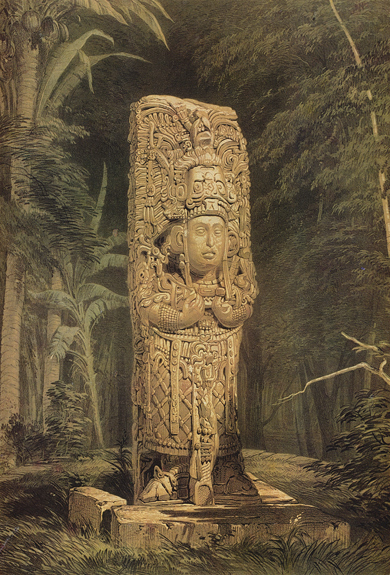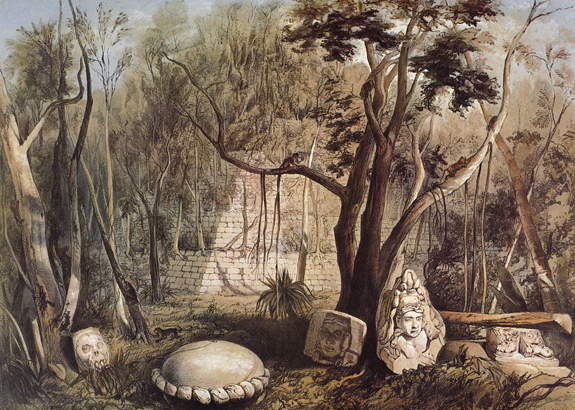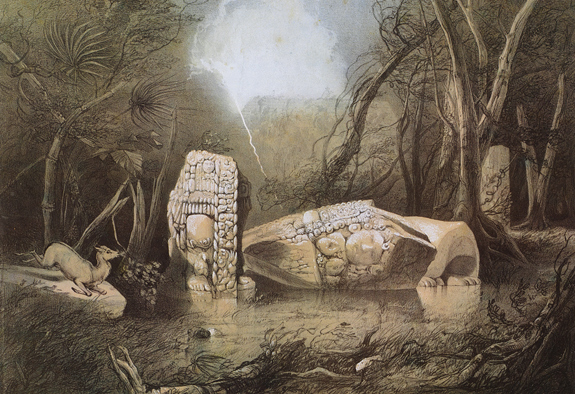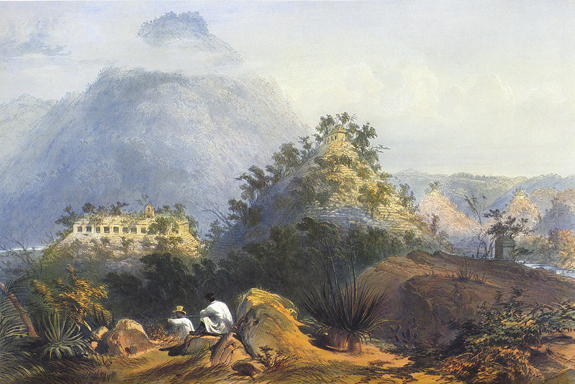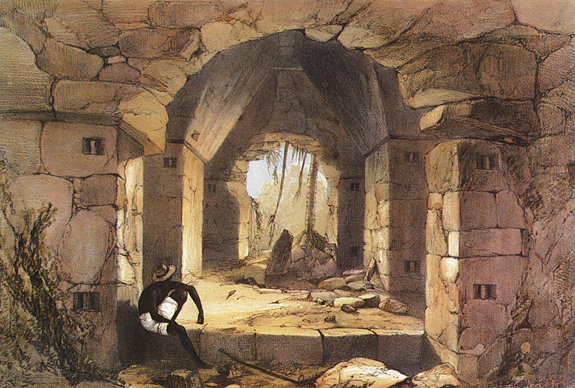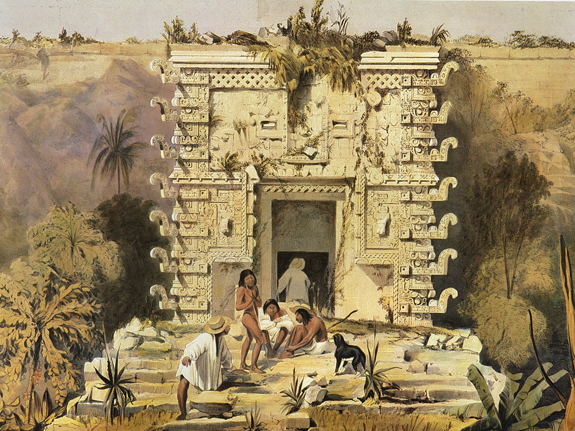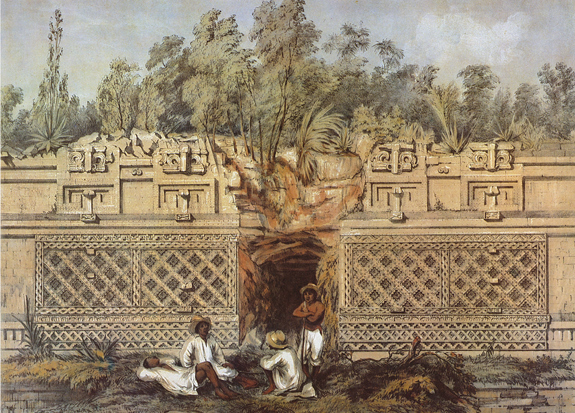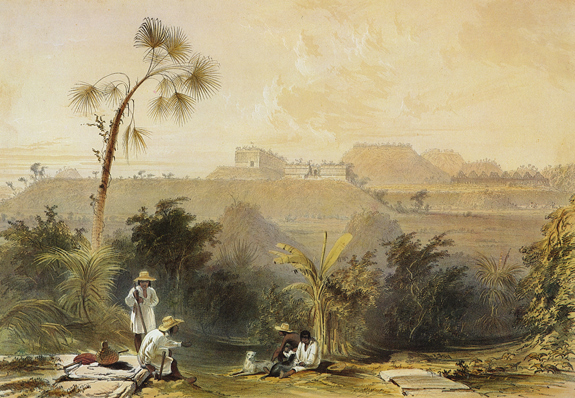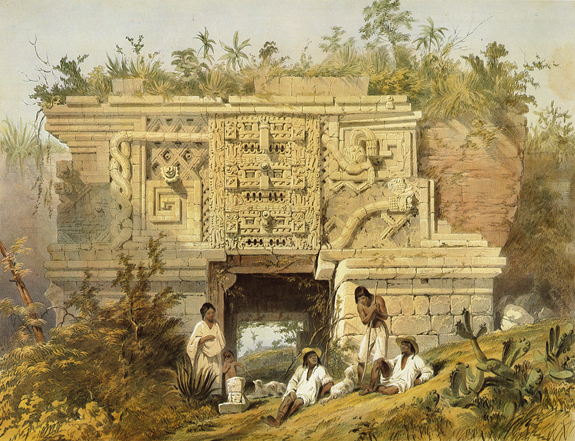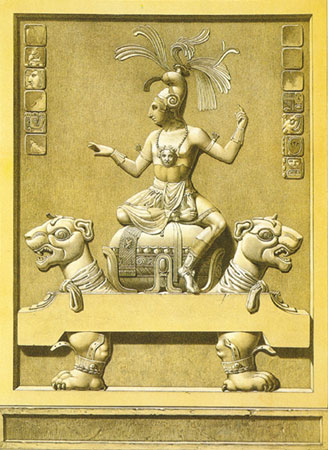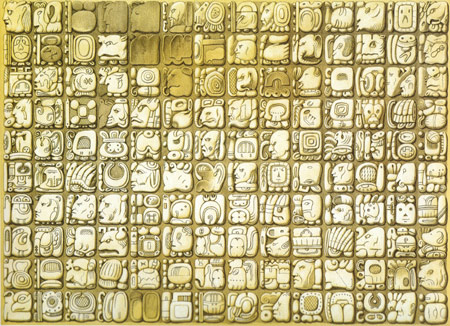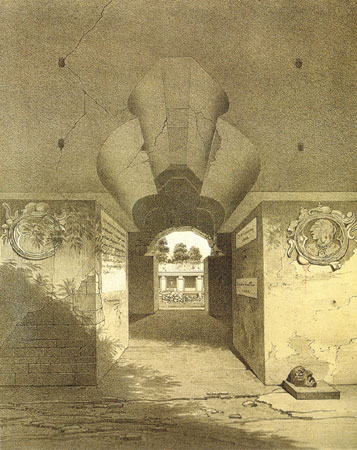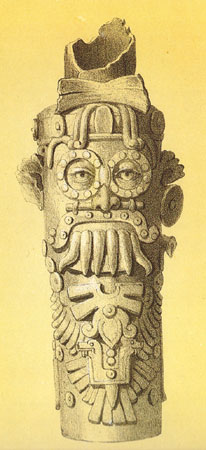Publicado el 28 de septiembre de 2006
_
Ornamento Sobre la Puerta del Gran Teocalis, Uxmal
_
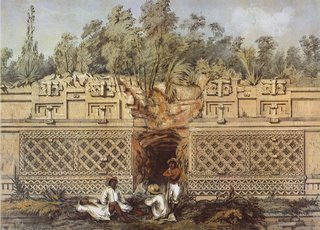

_"En el estudio de las civilizaciones antiguas, los mitos suelen evocar una sensación de misterio y motivar a la investigación más profunda de aspectos desconocidos de una cultura. Cuando John Stephens y Frederick Catherwood viajaron a Uxmal en 1840, los indígenas les contaron la leyenda de la Casa del Adivino.
__Según el relato de Stephens, una vieja mujer incubó de un huevo al hijo de un enano. El enano y el gobernador de Uxmal se desafiaron el uno al otro a realizar diversas hazañas para demostrar su fuerza. Una de ellas fue la de construir en una sola noche una casa que fuese más alta que todas las demás. Aunque el enano entró en desesperación a causa del reto, su madre le dijo que no se preocupase, y al día siguiente el enano se despertó en la que hoy en día se conoce como las casa del Enano (o del Adivino.). La leyenda de la Casa del Adivino, y el edificio mismo, capturaron la imaginación de los europeos, por lo que Catherwood representó el edificio en varias ocasiones. Stephens y Catherwood llamaron a la Casa del Adivino “el Gran Teocalis,” en referencia al teocalli, un templo prehispánico.
__Esta imagen muestra la fachada de la grandiosa estructura de la Casa del Adivino. La pared se distingue por su elegante obra de mampostería. Esta imagen pone en evidencia los efectos del paso del tiempo (desde la época en que los antiguos adoraban en el templo), ya que la fachada que antes estaba pintada yace ahora desnuda, y la sección central de la pared se ha derrumbado, revelando la entrada al templo interior. En primer plano se puede apreciar un ejemplo de las representaciones que hacía Catherwood de trabajadores indígenas en su tiempo de descanso, una escena que se repite en muchos otros grabados de esta colección".
__Según el relato de Stephens, una vieja mujer incubó de un huevo al hijo de un enano. El enano y el gobernador de Uxmal se desafiaron el uno al otro a realizar diversas hazañas para demostrar su fuerza. Una de ellas fue la de construir en una sola noche una casa que fuese más alta que todas las demás. Aunque el enano entró en desesperación a causa del reto, su madre le dijo que no se preocupase, y al día siguiente el enano se despertó en la que hoy en día se conoce como las casa del Enano (o del Adivino.). La leyenda de la Casa del Adivino, y el edificio mismo, capturaron la imaginación de los europeos, por lo que Catherwood representó el edificio en varias ocasiones. Stephens y Catherwood llamaron a la Casa del Adivino “el Gran Teocalis,” en referencia al teocalli, un templo prehispánico.
__Esta imagen muestra la fachada de la grandiosa estructura de la Casa del Adivino. La pared se distingue por su elegante obra de mampostería. Esta imagen pone en evidencia los efectos del paso del tiempo (desde la época en que los antiguos adoraban en el templo), ya que la fachada que antes estaba pintada yace ahora desnuda, y la sección central de la pared se ha derrumbado, revelando la entrada al templo interior. En primer plano se puede apreciar un ejemplo de las representaciones que hacía Catherwood de trabajadores indígenas en su tiempo de descanso, una escena que se repite en muchos otros grabados de esta colección".
_
______________________* * * * * * *
Ornament over the Gateway of the Great Teocallis
_
__"In the study of ancient civilizations, myths often evoke a sense of mystery and encourage further exploration into unknown aspects of a culture. When John Stephens and Frederick Catherwood journeyed to Uxmal in 1840, the indigenous people told them the legend of the House of the Dwarf.
__As related by Stephens, an old woman hatched a dwarf son from an egg. The dwarf and the ruler of Uxmal challenged each other to feats of strength, one of which was to build a house in one night that was higher than any other. Although the dwarf despaired at this challenge, his mother told him not to worry, and the next day the dwarf awoke in what is now called the House of the Dwarf. The legends of the House of the Dwarf, and the building itself, captured European imaginations, and Catherwood drew several scenes of the building. Stephens and Catherwood referred to the House of the Dwarf as the Great Teocallis, teocalli being a pre-Hispanic temple.
__This image depicts the façade of the superstructure of the House of the Dwarf. The wall is distinctive for its elegant stonework. The passage of time (since the ancients worshipped at the temple) is evident in this image, as the once-painted façade is now bare and the middle section of the wall has caved away, revealing an entrance to the inner temple. In the fore-ground is an example of Catherwood’s depiction of the indigenous workers reposing, a theme that extends to many other prints in this collection".
__"In the study of ancient civilizations, myths often evoke a sense of mystery and encourage further exploration into unknown aspects of a culture. When John Stephens and Frederick Catherwood journeyed to Uxmal in 1840, the indigenous people told them the legend of the House of the Dwarf.
__As related by Stephens, an old woman hatched a dwarf son from an egg. The dwarf and the ruler of Uxmal challenged each other to feats of strength, one of which was to build a house in one night that was higher than any other. Although the dwarf despaired at this challenge, his mother told him not to worry, and the next day the dwarf awoke in what is now called the House of the Dwarf. The legends of the House of the Dwarf, and the building itself, captured European imaginations, and Catherwood drew several scenes of the building. Stephens and Catherwood referred to the House of the Dwarf as the Great Teocallis, teocalli being a pre-Hispanic temple.
__This image depicts the façade of the superstructure of the House of the Dwarf. The wall is distinctive for its elegant stonework. The passage of time (since the ancients worshipped at the temple) is evident in this image, as the once-painted façade is now bare and the middle section of the wall has caved away, revealing an entrance to the inner temple. In the fore-ground is an example of Catherwood’s depiction of the indigenous workers reposing, a theme that extends to many other prints in this collection".
_
Anna NEWMAN (Exposición on line Drawing From the Past)





